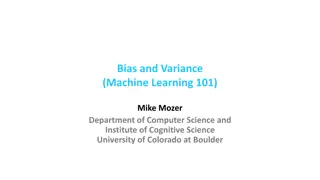Understanding Bias and Variance in Machine Learning Models
Explore the concepts of overfitting, underfitting, bias, and variance in machine learning through visualizations and explanations by Geoff Hulten. Learn how bias error and variance error impact model performance, with tips on finding the right balance for optimal results.
Download Presentation

Please find below an Image/Link to download the presentation.
The content on the website is provided AS IS for your information and personal use only. It may not be sold, licensed, or shared on other websites without obtaining consent from the author. Download presentation by click this link. If you encounter any issues during the download, it is possible that the publisher has removed the file from their server.
E N D
Presentation Transcript
Overfitting and Underfitting Geoff Hulten
Dont expect your favorite learner to always be best Try different approaches and compare
Bias and Variance Bias error caused because the model can not represent the concept Variance error caused because the learning algorithm overreacts to small changes (noise) in the training data TotalLoss = Bias + Variance (+ noise)
Visualizing Bias Goal: produce a model that matches this concept True Concept
Visualizing Bias Goal: produce a model that matches this concept Training Data for the concept Training Data
Visualizing Bias Bias Mistakes Goal: produce a model that matches this concept Training Data for concept Model Predicts + Bias: Can t represent it Model Predicts - Fit a Linear Model
Visualizing Variance Different Bias Mistakes Goal: produce a model that matches this concept New data, new model Model Predicts + Model Predicts - Fit a Linear Model
Visualizing Variance Mistakes will vary Goal: produce a model that matches this concept New data, new model New data, new model Model Predicts + Model Predicts - Variance: Sensitivity to changes & noise Fit a Linear Model
Bias and Variance: More Powerful Model Model Predicts + Powerful Models can represent complex concepts No Mistakes! Model Predicts -
Bias and Variance: More Powerful Model Model Predicts + But get more data Not good! Model Predicts -
Overfitting vs Underfitting Overfitting Fitting the data too well Features are noisy / uncorrelated to concept Modeling process very sensitive (powerful) Too much search Underfitting Learning too little of the true concept Features don t capture concept Too much bias in model Too little search to fit model 1 0.9 0.8 0.7 0.6 0.5 0.4 0.3 0.2 0.1 0 0 0.1 0.2 0.3 0.4 0.5 0.6 0.7 0.8 0.9 1
The Effect of Features Not much info Won t learn well Powerful -> high variance Throw out ?2 Captures concept Simple model -> low bias Powerful -> low variance New ?3
The Power of a Model Building Process Weaker Modeling Process ( higher bias ) More Powerful Modeling Process (higher variance) Simple Model (e.g. linear) Fixed sized Model (e.g. fixed # weights) Complex Model (e.g. high order polynomial) Scalable Model (e.g. decision tree) Small Feature Set (e.g. top 10 tokens) Large Feature Set (e.g. every token in data) Constrained Search (e.g. few iterations of gradient descent) Unconstrained Search (e.g. exhaustive search)
Ways to Control Decision Tree Learning Increase minToSplit Increase minGainToSplit Limit total number of Nodes Penalize complexity ? ^,??) + ? ???2(# ?????) ???? ? = ????(?? ?
Ways to Control Logistic Regression Adjust Step Size Adjust Iterations / stopping criteria of Gradient Descent Regularization ? # ???? ?? ^,??) + ? ???? ? = ????(?? |??| ? ?
Modeling to Balance Under & Overfitting Data Learning Algorithms Feature Sets Complexity of Concept Search and Computation Parameter sweeps!
Parameter Sweep # optimize first parameter for p in [ setting_certain_to_underfit, , setting_certain_to_overfit]: # do cross validation to estimate accuracy # find the setting that balances overfitting & underfitting # optimize second parameter # etc # examine the parameters that seem best and adjust whatever you can
Types of Parameter Sweeps Optimize one parameter at a time Optimize one, update, move on Iterate a few times Grid Try every combination of every parameter Quick vs Full runs Expensive parameter sweep on small sample of data (e.g. grid) A bit of iteration on full data to refine Gradient descent on meta- parameters Start somewhere reasonable Computationally calculate gradient wrt change in parameters Intuition & Experience Learn your tools Learn your problem
Summary of Overfitting and Underfitting Bias / Variance tradeoff a primary challenge in machine learning Internalize: More powerful modeling is not always better Learn to identify overfitting and underfitting Tuning parameters & interpreting output correctly is key























